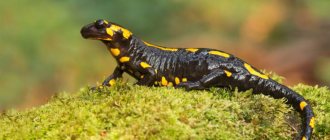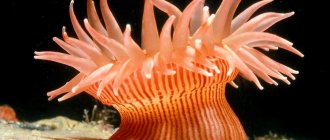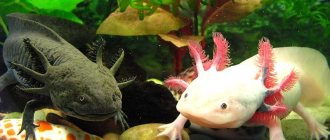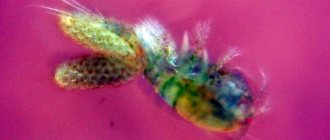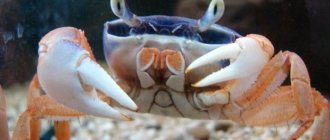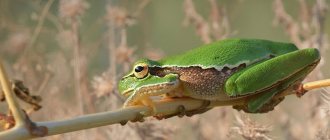Just two centuries ago, Alpine peasants warned brave naturalists who were going to get to know the small amphibian salamander: “Be careful with this terrible lizard - it is very dangerous! Firstly, it is terribly poisonous, and, secondly, it is very difficult to kill - it does not even burn in a fire, it gets out of the fire without damage...” We will talk about salamander venom below, but as for fire, this is nothing more than one of the ancient myths passed down from generation to generation. In fire, a salamander, of course, burns, like all living beings.
In medieval beliefs, the salamander was the spirit of fire. He was depicted as a burning lizard, which constantly lived in fire and personified its element. Perhaps the color of the amphibian seemed fiery to the people of the Middle Ages, and this real animal was called a salamander. Living salamanders were a permanent “professional” attribute of magicians and sorcerers.
Spreading
Lives in Europe from Spain and Portugal in the west to western Russia, Turkey and Israel in the east. Some salamanders live exclusively in water and differ from their relatives by well-formed gills, for example, the Chinese giant salamander is a representative of the cryptobranch . Salamanders belonging to the family of cryptobranchs live in the United States of America, China and Japan.
the family of lungless salamanders completely lost their lungs without gaining gills. Therefore, members of the family have to breathe using the skin and mucous membranes of the mouth. These salamanders live in tropical and subtropical forests, in mountains and lowlands, on plantations and in village gardens. Lungless salamanders are inhabitants of predominantly New World countries: they are distributed in areas covering the mountainous and forested areas of Canada, including the tropics and subtropics of Bolivia and Brazil. Several species live in European countries, and only one species (lat. Karsenia koreana) can be found in South Korea.
Representatives of the family of true salamanders , leading a predominantly terrestrial existence, have a respiratory system represented by a pair of well-developed lungs. True salamanders are widespread throughout Europe, living in the north-west of the African continent, Asia Minor and China, small species populations are found in Indochina and India, the range also covers areas from southern Canada to the northern regions of Mexico. Only four species of salamanders live in Russia.
Habitat
If you want to see the maximum diversity of salamanders, then you should go to North America - this part of the world is heavily favored by reptiles.
They also live in Asia and Europe, and some individual species are found in those places where they are most comfortable, regardless of the presence of nearby family members.
For example, in eastern China you can see the largest existing salamander. The giant reptile reaches 80 kg in weight and 180-190 cm in length (including the tail part of the body).
This species is called Chinese-giant, and despite its external danger, its representatives feed modestly: small fish, amphibians and invertebrates that live in the water.
The giant salamander is considered the largest amphibian at the moment, so it stands out not only among its species.
This is what a giant salamander looks like. This reptile prefers to live in forests and hills, but there must be a body of water nearby.
The Chinese-giant variety of these creatures is slowly beginning to die out, which is why the relevant organizations are holding various rallies and putting all their efforts into preserving the species.
So, despite their rather terrifying appearance, reptiles are actively protected.
Interesting! The fire salamander is the most common representative of this family; it lives throughout Europe, but it can also be found in Germany, Poland and Portugal. Individual populations can be found even in Turkey.
Appearance
All salamanders are similar in structure: they have an elongated body, a long tail, underdeveloped limbs and a small head. These animals move much better in water (as already mentioned, this mainly refers to the lungless type), precisely because of their short and undeveloped legs. Such tailed amphibians are very interesting due to their variety of colors and sizes: in nature you can find amazing representatives of some species that really look like miniature dragons.
An animal belonging to any type of salamander has movable eyelids, thanks to which it can examine the situation around it.
In addition, such tailed amphibians have very poorly developed jaws, and in general the oral region is not conducive to eating solid food. The fire salamander has a rather unusual coloring that will definitely attract the attention of any unlucky tourist. But behind the bright appearance lies a toxic poison that can kill several living creatures at once.
Most of all, this dangerous animal resembles a familiar lizard, for example, a gecko, while the differences between them are easily noticeable upon closer examination. It’s not just about the colors, which are more prominent in salamanders, but also about other factors. Poisonous amphibians have a slimy, long body and bright eyes.
- 35 facts about giraffes
- Animals of Crimea
- 36 facts about elephants
- Rodents
- 35 facts about foxes
- Animals of Brazil
In many myths, the salamander is designated as a servant of dark forces. Partly because of its danger to surrounding creatures, and also because of its unusual appearance, any member of the family in the past was considered a serious threat to people. At the same time, the poison of this amphibian cannot kill a person; the maximum effect after it is a burn.
Characteristic
Salamanders come in different types and sizes, but they all pose the same threat to other creatures. The fire salamander, just like all other species, is a poisonous amphibian.
It is important to consider that members of the family are divided into two types:
- real;
- lungless.
The latter are distinguished by the absence of lungs and can breathe exclusively through the skin.
This family currently numbers about 400 species, and this figure for tailed amphibians is simply huge.
But the number of real salamanders is even greater, and it is constantly increasing: scientists are still discovering new populations around the world.
By the way, it is the lungless type of these amphibians that can be seen much more often in the water.
Tailed amphibians, which have a full set of necessary organs, often go ashore and calmly walk along it.
Salamanders, which belong to the lungless type, differ in appearance from their counterparts. Their body is highly elongated, which is why such reptiles most closely resemble snakes. In the photo you can see what a salamander looks like without lungs.
Interesting! A giant salamander, if positioned vertically, would be taller than the average man. This animal reaches 1.7 meters in length, thanks to which it holds the title of “the largest tailed amphibian.” Well, the smallest representative of the family does not exceed the size of a 5-kopeck coin.
Salamander species
The modern classification includes several hundred species of salamanders, which belong to different families. Below is a description of several varieties of salamanders:
- Fire salamander , also known as spotted salamander or common salamander (lat. Salamandra salamandra) is the most numerous species on European territory, whose representatives are distinguished by their large size, long life expectancy (in captivity up to 50 years) and bright aposematic (warning) coloring. The length of the salamander, including the tail, ranges from 23 to 30 cm. The main color of the body is black, strewn with contrasting orange or yellow spots, which are located evenly throughout the body, but have an irregular shape. Symmetry is present only on the paws and head. The fire salamander is distinguished from many members of the family by viviparity and fear of water. Animals are forced to descend into reservoirs only during the breeding season.
- Lusitanian salamander (golden-striped salamander) (lat. Chioglossa lusitanica) is a rare species of amphibian, representatives of which grow up to 15-16 cm in length, but have a very long tail, making up 2/3 of the total length of the body. The color of the salamander is black, with 2 thin golden stripes or golden spots located in a row along the ridge. The entire surface of the back is dotted with small blue specks. A distinctive feature of the animal is that the Lusitanian salamander catches prey using its tongue thrown forward, just like frogs do. The salamander lives exclusively in the northern regions of Spain and Portugal.
- The Alpine salamander (black salamander) (lat. Salamandra atra) looks like a fire salamander, but has a more graceful body and uniform black skin color. The body length of adult animals reaches 9-14 cm (sometimes 18 cm). Alpine salamanders live at altitudes of up to 700 meters above sea level, preferring rocky landscapes and the banks of mountain streams. The species' range extends through the central and eastern regions of the Alpine ranges: from Switzerland and Austria to Serbia, Croatia and Montenegro.
- The spectacled salamander, also known as tarantolina (lat. Salamandrina terdigitata), is distinguished by a V-shaped pattern located on its head, the shape of which resembles glasses. The body color is dark brown, almost black; the “spectacles” can be red, yellow or white. The salamander's abdomen is bright red, which the animal demonstrates to the enemy as a frightening technique. The species' range is extremely narrow: the spectacled salamander can only be found in the south of Italy, in the humid forests of the Apennine Mountains.
- The Caucasian salamander (lat. Mertensiella caucasica) is a rare species of long-tailed salamander with a body length of no more than 15 cm, most of which is the tail. The body is narrow, brown or black, and in most representatives of the species it is covered with bright yellow oval spots, which resembles a fire salamander. But unlike the latter, the Caucasian salamander moves quickly, like a lizard, and swims well. The animal is classified as vulnerable and lives exclusively in wooded areas and along the banks of water bodies in Turkey and Georgia.
- The slender salamander (lat. Plethodon richmondi) is distinguished by a thick head, graceful physique and strong, developed legs. The salamander's body length ranges from 7.5 to 14.5 cm. The body is brown or black and covered with silvery spots. The salamander lives in the northeastern states of the USA (Tennessee, Virginia, Kentucky).
- The spring salamander (lat. Gyrinophilus porphyriticus) is extremely prolific and is capable of laying up to 132 eggs. The body, growing from 12 to 23 cm in length, is distinguished by a bright red or orange-yellow color with small dark spots. The salamander lives in the United States and Canada in the mountainous regions of the Appalachians.
- The Pacific salamander (lat. Ensatina eschscholtzii) is distinguished by a small thick head, a strong slender body about 14.5 cm long and wrinkled skin on the sides, forming small folds. A typical inhabitant of the mountain landscapes of Canada, the USA and Mexico.
- The tree salamander (lat. Aneides lugubris) grows in length from 7 to 12 cm and has an inconspicuous light or dark brown color. The salamander has a muscular tail, on which it rests, deftly climbing trees, jumping well over short distances and squeaking loudly. The narrow habitat of the species is limited to the American state of California and the Mexican state of Baja California.
Behavior
The spotted salamander is a nocturnal animal and can only be seen during the daytime after a rainstorm. She spends the whole day in a hole abandoned by rodents, a crevice among stones, under a fallen old tree or in a hollow.
If necessary, she can independently dig a shelter about 40 cm long and 4-6 cm wide in soft soil.
With the onset of cold weather, this creature becomes numb, having previously chosen a secluded place with high air humidity and protected from frost. Basements, wells, caves or grottoes are suitable for hibernation.
Good protection for the amphibian is its poisonous behind-the-ear glands (parotids) and two more rows of poisonous glands located on the back all the way to the tail. They are capable of secreting yellowish or white mucus, which when dried in the sun acquires a bitter taste. The toxins it contains can cause inflammation of the mucous membrane in predators.
The fire salamander releases toxins as a reflex when it is squeezed or struck.
The stronger the voltage, the more poison the amphibian can release. For this reason, only some snakes decide to attack adults.
Character and lifestyle of the salamander
Salamanders, although they are loners, gather in groups before hibernation in October. To survive this unfavorable period for them together on land, in heaps of fallen leaves.
They hunt mainly at night, and during the day they hide in shelters from direct rays of the sun. As a rule, there should be a body of water near their habitat. They overtake their prey with a sharp jerk and cover it with their body. After a short struggle, the victim is swallowed whole.
The salamander has many natural enemies; in order to escape, the animal leaves its tail or limbs in their claws and teeth and quickly runs away.
Although these amphibians are poisonous, their secretion does not cause mortal harm to humans. It can only cause irritation on the hands, and if it gets on the mucous membranes, it can burn the mouth or eyes. Therefore, after touching an amphibian, you need to wash your hands well so as not to harm yourself through carelessness.
Today, many people want to keep this mythical amphibian at home. You can buy fire salamanders in special nurseries or pet stores. They will need a large horizontal terrarium to live. A mixture of leaves, sphagnum and peat is usually poured onto its bottom. There is a small pond inside. The lighting should be dim and the temperature should not exceed 25 degrees.
Natural enemies
The salamander has a lot of natural enemies, and in order to save its life, such an unusual animal has adapted to leaving its limbs or tail in the teeth or claws of predators in order to have time to escape. For example, the natural enemies of the Fire Salamander species are snakes, including common and water snakes, predatory fish, large birds and wild boars.
Salamanders are often caught by people, since today many connoisseurs of various indoor exotics prefer keeping such a mythical amphibian at home. For humans, the poison secreted by salamanders is not dangerous and contact of the toxin with the mucous membranes only causes a burning sensation, but under conditions of too much stress such an animal is capable of spraying toxic substances over a relatively long distance.
What do salamanders eat?
They are classified as nocturnal inhabitants. In the wild, they go hunting at night. From night until dawn they are able to track their prey. To get food, salamanders attack the prey with their whole body and then try to swallow it whole.
The diet of the animals depends on the habitat. Individuals living in water feed on small fish, snails, crayfish, mollusks, crabs, as well as small insects, amphibians, and mammals.
Living on the ground, the salamander hunts larvae, snails, worms, slugs, and also eats various insects. Among them: butterflies, mosquitoes, spiders and flies. Large representatives of the family catch small newts and young frogs.
Description
Body length reaches 10-24 cm, maximum 32 cm. Females are larger than males and have a stockier build. There is no sexual dimorphism in color.
The wide head with bulging eyes ends in a rounded muzzle. The mouths of the poisonous glands are clearly visible. The skin is moist, shiny and sticky.
The black back is covered with bright yellow, orange or red spots. On the massive body along the back there are poisonous glands. There are four toes on the forelimbs and five on the hind limbs. The round, blunt tail is shorter than the body.
The lower part of the body is covered with thin gray-black or gray-brown skin.
The lifespan of a fire salamander in the wild rarely exceeds 10 years. In captivity, she lives up to 20-24 years.
Salamander reproduction and lifespan
On average, salamanders live about 20 years, the duration depends on the size of the particular species. Small species reach sexual maturity by 3 years, and large ones by 5 years.
Hypnobranchs lay eggs, and true salamanders are viviparous or ovoviviparous.
- Reproduction: males are very active during the mating season and are ready to attack any moving object that resembles a female; they also fight with each other for the female’s attention. Fertilization is internal, occurring either on land or in water. Shortly before the larvae hatch, the females enter the water. Large larvae located in the womb of the salamander mother eat their sisters and brothers, who turn out to be slightly smaller in stature. The larvae have no connection with the mother; she gives them nothing except shelter. The usual fertility of a female is 6-30 larvae.
- Breeding season/period: spring to autumn.
- Puberty: occurs at the age of 3-4 years.
- Courtship ritual: the male clasps the female from below. The spermatophore is deposited on the female’s body, and the male, helping her, moves it with his paws closer to the cloaca. The female captures the spermatophore with the cloaca.
- Egg incubation: lasts 8-10 months.
- Development: in water, the female salamander gives birth to almost fully formed larvae (weight about 0.2 g, length 25-30 mm). They have three pairs of feathery external gills, yellow spots are visible at the base of the limbs, the tail is long, flattened, trimmed with a wide fin fold that turns into a crest on the back. The head is large, round, the body is high, laterally compressed. Fire salamander larvae are predators and often engage in cannibalism. The larval period lasts all summer, metamorphosis ends in August-September, with a larval length of 50-60 mm. Fully formed small salamanders begin to breathe with their lungs and leave the pond. Before the end of metamorphosis, the larvae begin to crawl along the bottom, often rising to the surface of the water for air.
Life cycle
The reproduction process of fire salamanders has not been fully studied. In addition, significant differences are known in the reproductive cycles of salamanders of this species, depending on the habitat and its altitude above sea level. [2]
The breeding season usually begins in early spring. At this time, in the male’s cloaca area, the convex gland that produces the spermatophore becomes more noticeable.
Two subspecies of fire salamanders - S. s. fastuosa
and
S. s.
bernardezi are viviparous animals; the female does not lay eggs, but gives birth to larvae. The remaining subspecies practice ovoviviparity.
Representatives of the species reach sexual maturity at the age of 3 years. Life expectancy in the natural environment is up to 14 years, some specimens lived up to 50 years in captivity.
Keeping at home
These amphibians are kept in a terrarium at home. It is necessary to fill the bottom with soil. It should be a mixture of soil, moss, coal and peat. Salamanders love to burrow into moss. But it dries out quite quickly. Therefore, it needs to be updated periodically. To create conditions as close as possible to natural conditions, it is important to place one more thing in your pet’s house. These are dry driftwood, stones, and it is also good to plant several living plants.
The amphibian enjoys taking baths. Therefore, it is necessary to place a pond in the terrarium. Be sure to keep it clean. Change the water and rinse the container from time to time. It is not recommended to place two males in one house. The ideal option is several females and one male.
The salamander does not tolerate heat very well. Therefore, it is best to place the terrarium in dark places. For lighting, use fluorescent lamps, which must be purchased additionally. Buy a humidifier too. The humidity in the pet's home must be constantly maintained at a level of at least 75%.
It is often not recommended to pick up an amphibian. Animals do not like too much tactile contact. In addition, they secrete a secretion that can cause irritation on the skin. It is important to create a balanced diet for your pet. Despite being kept in captivity, salamanders have an excellent appetite. The main thing is not to overfeed them. You need to give food 2 times a day. Please note that pets may completely refuse to eat for several days, or even weeks. This is normal before shedding and during hot weather.
The main diet of salamanders should consist of live insects. These are slugs, butterflies, beetles, crickets, caterpillars and flies. Sometimes you can give some fresh fish, beef liver or heart - also raw.
Salamander breeding
Puberty in salamanders occurs at the age of two to four years, usually when they reach a length of 12-14 cm. Mating occurs after wintering. Therefore, if you plan to breed amphibians, then they need to create a wintering area artificially - first lower the temperature to +8...+14 degrees, and then (in April) raise it to +18...+23. Plus, you can place more items in the terrarium where the couple can hide. During wintering, food is not offered to amphibians.
Mating begins in April-May. Salamanders are viviparous animals, so 9-10 months after fertilization, the female will lay larvae in the water. The number of larvae can reach 25-30.
Immediately after birth, the babies will need to be placed in a separate aquarium with mandatory aeration and filtration and maintaining a water temperature of +12-17 degrees. The aquarium must have a dry area. The babies need to be fed with corret, cyclops, daphnia, etc. After three to five months, the babies will reach a size of 5 cm and will be able to go onto land.
Health and characteristic diseases
Diseases characteristic of tailed amphibians:
- burns;
- parasites and mites;
- insect bites;
- infected wounds or cutaneous mycosis;
- benign tumors;
- saprolegnia fungus.
If during molting you notice that your salamander is passive and often freezes, there is no need to worry. This is normal during this period. You just need to leave her alone and not pick her up. The amphibian falls into a state of torpor in winter, as well as during bad weather. The salamander is an excellent exotic pet.
Having such a miracle in your home, you will definitely not be bored, because observing the behavior of an exotic animal brings great pleasure. The amphibian feels great in captivity, does not require special care and does not cause any problems in the form of noise, dirt or other discomfort. It can be started by a beginner. You can purchase a salamander for between $15 and $40.
Biological rhythms of life
The domestic salamander needs constant daylight. Daylight hours for salamanders throughout most of the year (except winter) are 12 hours. Based on this, the terrarium is illuminated and heated. This can be done with an ultraviolet lamp with UVB 2%. It illuminates the terrarium well, but hardly irradiates it. Erythema lamps are a good source of ultraviolet radiation, but they need to be used in doses - 15 minutes a day, evenly distributing the time into three periods of 5 minutes. In this case, the reflected light flux must fall on the animals, their skin and surroundings must be dry.
Interesting Facts
- The fire salamander, like all species from this family, has a toxic venom that is found on the surface of its skin. It is secreted by the parotid glands, and this process occurs constantly. The peculiarity is that if, for example, a dog eats a salamander, it will soon die.
- The poison of these animals is called salamandrin in chemistry. It is really dangerous for humans only when consumed internally, which is why the use of these amphibians as food is prohibited. It is also noteworthy that they use their poison exclusively for the purpose of self-defense, and not for hunting.
- The giant salamander prefers to be in water, or to be more precise: in cold and fast-flowing mountain streams. And, despite its large size, this animal does not disdain to feed on insects and crustaceans, alternating them with fish. The activity period of this species is at night.
- All salamanders have the ability to regenerate not only the tail, but also the rest of the limbs. In this feature they resemble lizards, but in this factor they are also ahead of them in development.
- They say the fire (spotted) salamander only reproduces when there is a strong thunderstorm. Similarly, during riots, ignorant people try to achieve some position in society.
- According to German mythology, this family of amphibians personifies the spirit of fire. Moreover, the Germans in their stories attribute to salamanders the ability to tolerate combustion temperatures without any damage. From the point of view of the Christian faith, these creatures are messengers of the devil. And indeed, judging by the way the salamander looks, one might get such an impression.
- Many species are listed in the Red Book as they are endangered. This is due to the fact that animals are hunted to obtain poison. And in certain countries their meat is considered a delicacy.
- The official symbol of Alabama (USA) is the burrow salamander.
- On sunny days, the amphibian does not leave the cool and dark shelter. Those who plan to commit a crime under cover of night behave in a similar way.
- The salamander is not a lizard, but belongs to the class of amphibians. In the same way, one should not confuse foul language with a demon from the depths of hell.
- If hair falls out from the venom of a spotted salamander, then a person’s honor and good name are lost from slander.
- Beautiful spots on the back of an animal can symbolize hypocrisy, which always wears an attractive mask.
Video
Nutrition
The diet of such a tailed amphibian as the salamander depends to a small extent on its species.
Predators among these animals can be counted on the fingers of one hand, while populations of the family are found in all corners of the world.
This is largely due to the underdeveloped jaw and innate laziness of this group. In general, the daily menu of each of its representatives most often includes:
- caterpillars;
- spiders, cicadas and butterflies;
- slugs and earthworms;
- small newts and frogs (the fire salamander especially loves them).
If we talk about larger individuals of these amphibians, then they prefer to use;
- small amphibians;
- fish;
- crustaceans.
This diet is preferred by the giant salamander and some other individuals of this family that live in water bodies. These creatures go hunting at night; during the day their activity is extremely low.
In addition, they prefer not to attack predators, and reduce the likelihood of collisions with potential enemies to a minimum.
In the photo you can see how the giant salamander rested in the man’s arms. This once again challenges the idea that these creatures are capable of eating people.
Interesting! By the way, there is also a myth about the immortality of the salamander. At one time, people were so afraid of these animals that they attributed fantastic abilities to them, so some facts of the past regarding this family are greatly distorted.

